
(a)
Interpretation:
The differences in the structural formula of testosterone and methandrostenolone should be determined along with
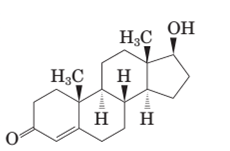
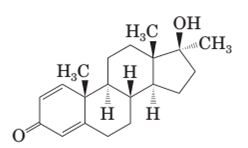
Concept Introduction:
Steroids are the third major class of lipids. These are the compounds containing the following ring system:
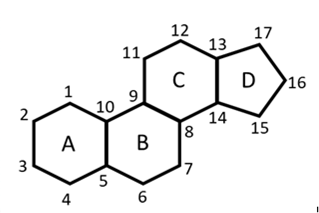
Answer to Problem 17.76P
Both methandrostenolone and testosterone hormone contains hydroxyl functional group (alcohol) and carbonyl functional group (kentone).
In the structural formula of testosterone hormone, there is only one double bond and it has only one methyl group attached to cyclopentane ring whereas in methandrostenolone there are two double bonds and two methyl groups are attached to the cyclopentane ring.
Explanation of Solution
Testosterone and methandrostenolone both the hormones contain one −OH group attached to cyclopentane ring and one >C=O group in cyclohexene ring. Therefore both alcoholic and
In the structure of testosterone there is only a double bond in cyclohexene ring having ketonic group and no methyl group is present on the carbon of cyclopentane ring having alcoholic group as shown:
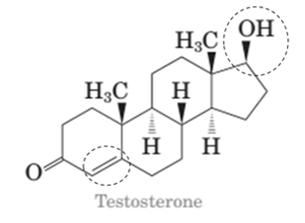
In the structure of methandrostenolone, there are two double bonds in cyclohexene ring having ketonic group and one methyl group attached on the carbon of cyclopentane ring having alcoholic group as shown:
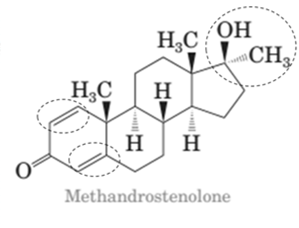
(b)
Interpretation:
In both the given hormones mark all the stereocenters and state the number of stereoisomer possible for each.

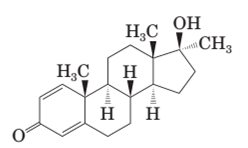
Concept Introduction:
Stereoisomers are the compounds that are differ only in the spatial arrangement of their atoms. Each stereoisomer has at least one stereocenter. A stereocenter is a tetrahedral carbon atom that has four different groups bonded to it. For a molecule with n sterocenters, a maximum of
Answer to Problem 17.76P
Stereocenters in testosterone:
Since testosterone has six stereocenters therefore it has 64 possible stereoisomers.
Stereocenters in methandrostenolone:
Since methandrostenolone has six stereocenters therefore it has 64 possible stereoisomers.
Explanation of Solution
A stereocenter is a tetrahedral carbon atom that has four different groups bonded to it.
Stereocenters in testosterone:
In testosterone there are six stereocenters.
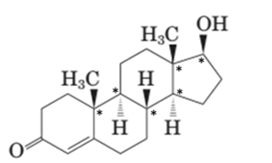
For a molecule with n stereocenter, a maximum of
Stereocenters in methandrostenolone:
In methandrostenolone there are six stereocenters.
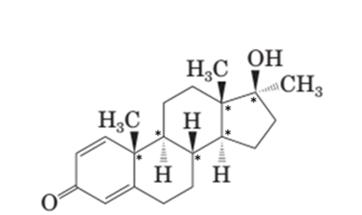
For a molecule with n stereocenter, a maximum of
Want to see more full solutions like this?
Chapter 17 Solutions
Introduction to General, Organic and Biochemistry
- 16-28 Following is the structural formula of metformin, the hydrochloride salt of which is marketed as the antidiabetic medication Glucophage. Metformin was introduced into clinical practice in the United States in 1995 for the treatment of type 2 diabetes. More than 25 million prescriptions for this drug were written in 2000, making it the most commonly prescribed brand-name diabetes medication in the nation. NH NH H3(\ 3 N N Nh2ch3 h Metformin Complete the Lewis structure for metformin, showing all valence electrons. Which nitrogen is the most likely site of protonation? Draw the structural formula of Glucophage.arrow_forward17-54 Following is the structure of immunosuppressant FK-506, a molecule shown to disrupt calcineurin-mediated signal transduction in T-lymphocytes. (a) There are three carbon—carbon double bonds present in this molecule. Which of the three has the potential for cis/trans isomerism? Assign a cis or trans con?guration to each carbon-carbon double bond that has this possibility. (b) How many stereocenters are present in this molecule? How many stereoisomers are possible for it? (c) Are there any aromatic components in this molecule? (d) Consider the two carbon atoms marked with asterisks. Assign an R or S con?guration of each stereocenter. (e) Because of the presence of a 21-member ring, this molecule is described as a macrocycle. This ring is fashioned by three types of bonds, several carbon-carbon bonds, one ester, one hemiacetal, and one amide. Locate the ester and the hemiacetal. (f) Draw the structural formula of the long chain compound that would result if the hemiacetal were to be cleaved to an alcohol and a carbonyl group.arrow_forward19.62 Naltrexone is used to help recovering narcotic addicts stay drug free. HO O OH naltrexone LO1,6,7 (a) Label and name all the functional groups. Where relevant, indicate whether the group is primary, secondary or tertiary. (b) Upon addition of dilute hydrochloric acid solution, naltrexone forms a water-soluble salt. Draw the structure of this salt.arrow_forward
- Look up the structure of lisdexamfetamine (Vyvanse), a drug used in the treatment of attention deficit hyperactivity disorder (ADHD). Redraw it and identify all the functional groups present. What is known about itstherapeutic properties?arrow_forwardIn an attempt to synthesize compound C through a two-step process, a chemist discovered after completing the first step that they had inadvertently produced two distinct compounds, A and B. Upon examining the infrared spectroscopy (IR) results, it was observed that both A and B exhibited peaks indicative of a ketone and an ester group. Please provide the molecular structures of A and B. OEt NaOEt ΕΙΟ A B In a chemical experiment, they noticed that both components, A and B, from a combined sample turned into a new compound, C, during the following stage. The task is to determine what compound C looks like and explain how compound A or B changes into compound C through a reaction. Compound C should be the primary molecule containing carbon created in this process, not just a by-product. A B H3O+, H₂O, A Mechanism = сarrow_forwardDimethyl disulfide, CH,S–SCH3, found in the vaginal secretions of female hamsters, acts as a sexual attractant for the male hamster. Write an equation for its synthesis from methanethiol.arrow_forward
- Describe concisely a chemical test to distinguish between the following pairs ofcompounds. (a) Pentan-2-one and pentan-3-one(b) Propanal and propanone(c) Phenol and anilinearrow_forward17-45 How would you synthesize the following alcohols, starting with benzene and other alcohols of six or fewer carbons as your only organic reagents? (a) (b) (c) OH CH₂CH3 HO CH3 CH₂CH₂CH3 CH3 CH3CH₂CH₂CHCH₂CH₂OH (d) CH3 OH CH3CHCH₂CHCH₂CH3arrow_forward10carrow_forward
- A postgraduate student wanted to synthesized two carbonyl compounds known as compounds M and N using oxidation of alcohol. However, these carbonyl compounds should have more than 6 carbon atoms. Draw two (2) possible structural formulae for compounds M and N. How would you distinguish between compounds M and N?arrow_forwardList the structural features common to each of these molecules.arrow_forwardIdentify which of the statements is/are correct. (i) The molecular formula of the smallest aldehyde is C3H6O, and that of the smallest ketone is also C3H6O. (j) The molecular formula of the smallest carboxylic acid is C2H4O2.arrow_forward
 Introduction to General, Organic and BiochemistryChemistryISBN:9781285869759Author:Frederick A. Bettelheim, William H. Brown, Mary K. Campbell, Shawn O. Farrell, Omar TorresPublisher:Cengage Learning
Introduction to General, Organic and BiochemistryChemistryISBN:9781285869759Author:Frederick A. Bettelheim, William H. Brown, Mary K. Campbell, Shawn O. Farrell, Omar TorresPublisher:Cengage Learning Organic ChemistryChemistryISBN:9781305580350Author:William H. Brown, Brent L. Iverson, Eric Anslyn, Christopher S. FootePublisher:Cengage Learning
Organic ChemistryChemistryISBN:9781305580350Author:William H. Brown, Brent L. Iverson, Eric Anslyn, Christopher S. FootePublisher:Cengage Learning

